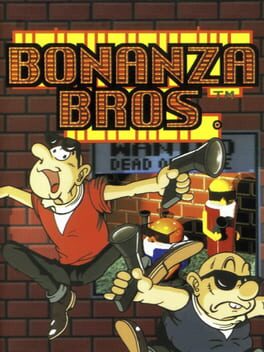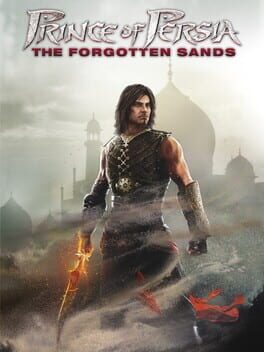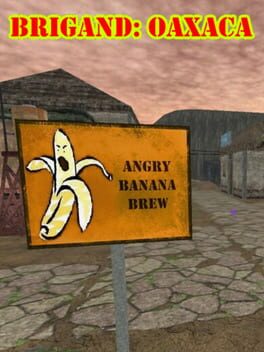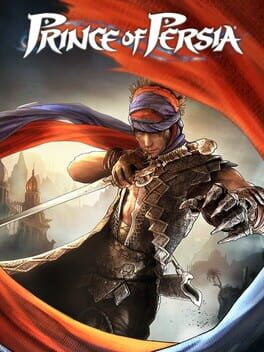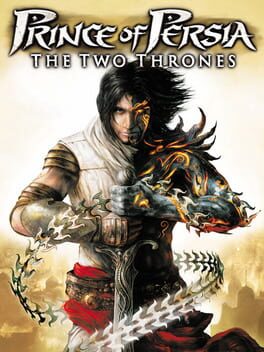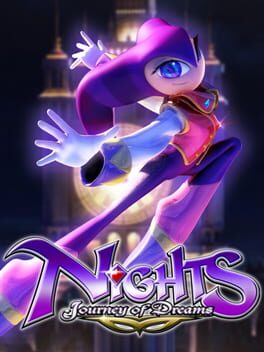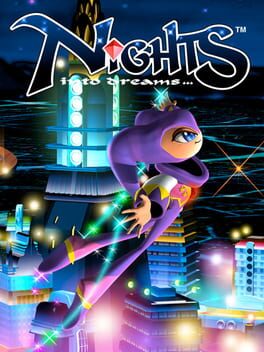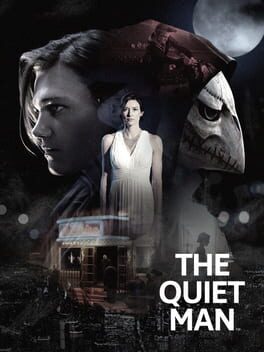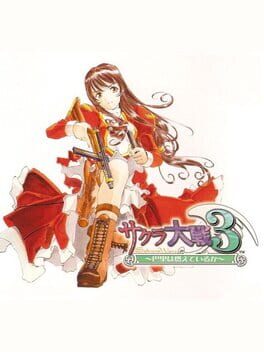BaronUnread
154 Reviews liked by BaronUnread
Bonanza Bros.
1990
Bonanza Bros is a game that some people might remember as "those yellow guys from that Sonic racing game", which is the only reason why I know this game myself. It's a shame because despite the fact that this game has been completely forgotten, it's something unique and worth playing, as most Sega games used to be from this time period.
This is a stealth/action game, you have X items per level to get on a time limit and that means that every decision has to be taken quickly and a mistake such as going on a different route could screw up an entire run of a level. The weird controls and small screen space might seem disorienting at first, but there's a certain logic in how it works and getting a good time (or managing to finish a level when the time limit is almost up) is always satisfying.
The controls are more of an issue in the second half, when the game is more action than stealth. Suddenly you're asked to be very quick with your reflexes but since there's always a slight delay in every movement the little Bonanza character makes, it doesn't make for very fun or fair gameplay.
Despite that though, you can't go wrong with trying out Bonanza Bros and having 30 to 45 minutes of fun with it (seriously, with its 10 stages and lower difficulty than usual for a game of its time, it feels really short even for a Mega Drive game). It has a lot of personality, unique and fun gameplay, and you'll finally have some context for who those Lego ass looking guys are in that Sonic racing game.
This is a stealth/action game, you have X items per level to get on a time limit and that means that every decision has to be taken quickly and a mistake such as going on a different route could screw up an entire run of a level. The weird controls and small screen space might seem disorienting at first, but there's a certain logic in how it works and getting a good time (or managing to finish a level when the time limit is almost up) is always satisfying.
The controls are more of an issue in the second half, when the game is more action than stealth. Suddenly you're asked to be very quick with your reflexes but since there's always a slight delay in every movement the little Bonanza character makes, it doesn't make for very fun or fair gameplay.
Despite that though, you can't go wrong with trying out Bonanza Bros and having 30 to 45 minutes of fun with it (seriously, with its 10 stages and lower difficulty than usual for a game of its time, it feels really short even for a Mega Drive game). It has a lot of personality, unique and fun gameplay, and you'll finally have some context for who those Lego ass looking guys are in that Sonic racing game.
Prince of Persia The Forgotten Sands might be the most utilitarian game I played in a while. Following the half disaster that the reboot was Ubisoft probably felt the need to slow down with the IP and make something safe, hence this being a prequel, which has to be the number 1 sign that a developer doesn't really know what to do with a series.
There aren't many novelties to mention here, they reworked the combat for the 4th time in this five game series, going for functionality over originality. It's probably the most straight forward and functional combat the series ever had, but I think they lost a lot by turning it into a standard hack n slash game, making it especially jarring since the Prince will suddenly become a lot less mobile during combat.
There's also some PoP 2008 DNA still in this game, mainly in the controls and animations which don't quite feel right. It's not that it plays badly, but a lot of the weight that the Prince's movement and actions used to have isn't really here, instead favoring the 2008 approach of making it look nice instead of making it feel particularly good.
Outside of this there isn't much to say. There's a couple new platforming mechanics which are interesting and make things fun and varied, even though one of them comes into play too late into the game, and all in all this is pretty typical Prince of Persia fare. It's the kind of game that will provide entertainment if you decide to engage with it, but you don't miss much by not playing it, which would be fine if this was some sort of filler game (which seems to have been the original intention for it) but as of this review they haven't made a new Prince of Persia game since, and there doesn't seem to be anything new on the horizon either.
Then again, if Prince of Persia was about to become a series of entertaining but unexciting games like this one, maybe it's for the best.
There aren't many novelties to mention here, they reworked the combat for the 4th time in this five game series, going for functionality over originality. It's probably the most straight forward and functional combat the series ever had, but I think they lost a lot by turning it into a standard hack n slash game, making it especially jarring since the Prince will suddenly become a lot less mobile during combat.
There's also some PoP 2008 DNA still in this game, mainly in the controls and animations which don't quite feel right. It's not that it plays badly, but a lot of the weight that the Prince's movement and actions used to have isn't really here, instead favoring the 2008 approach of making it look nice instead of making it feel particularly good.
Outside of this there isn't much to say. There's a couple new platforming mechanics which are interesting and make things fun and varied, even though one of them comes into play too late into the game, and all in all this is pretty typical Prince of Persia fare. It's the kind of game that will provide entertainment if you decide to engage with it, but you don't miss much by not playing it, which would be fine if this was some sort of filler game (which seems to have been the original intention for it) but as of this review they haven't made a new Prince of Persia game since, and there doesn't seem to be anything new on the horizon either.
Then again, if Prince of Persia was about to become a series of entertaining but unexciting games like this one, maybe it's for the best.
Brigand: Oaxaca
2017
This is a really cute and charming game. Its also a frustrating and tedious mess. For every hour of loveable charm this game offers there is another of monotony, with the odd helping of bullshit permeating it. I’d say the charm is worth the frustration, but this is as much a test of patience as skill. I played it on easy mode and I'd still consider it one of the more challenging games I've played. Throughout most of the game one on one enemy encounters feel like a coin toss more than a fair fight. The average fight goes like this:
Does my bullet miss? Ok what move are they doing? Right I'm dead.
Everything kills you quickly in this game, but thankfully virtually everything can be killed in a matter of seconds. This is a great way of making the gameworld feel dangerous while at the same time realistic. You really feel like every enemy has set stats and inventory uses like yourself, which further immerses the player in Brigand’s lo-fi, old school aesthetic.
If unpredictable and arguably unfair combat will stop you from playing this, there’s no shame. It’s hard to recommend this, especially considering that I had to message the developer to fix bugs during my playthrough. That said there’s a lot of freedom of choice considering the small ensemble of cast members and factions, a lot of different builds to play around with, the loveable characters one dimensional to the point of parody, the dated visuals cohesive in their incohesiveness. And the soundtrack is full of songs straight out of Machinimas from the early 2010s. Fans of Deus Ex, System Shock, E.Y.E. Divine Cybermancy, S.T.A.L.K.E.R. and the early Fallout titles will find something to love here.
If you’re reading this Brian, thanks you, this is a game I won’t soon forget.
Does my bullet miss? Ok what move are they doing? Right I'm dead.
Everything kills you quickly in this game, but thankfully virtually everything can be killed in a matter of seconds. This is a great way of making the gameworld feel dangerous while at the same time realistic. You really feel like every enemy has set stats and inventory uses like yourself, which further immerses the player in Brigand’s lo-fi, old school aesthetic.
If unpredictable and arguably unfair combat will stop you from playing this, there’s no shame. It’s hard to recommend this, especially considering that I had to message the developer to fix bugs during my playthrough. That said there’s a lot of freedom of choice considering the small ensemble of cast members and factions, a lot of different builds to play around with, the loveable characters one dimensional to the point of parody, the dated visuals cohesive in their incohesiveness. And the soundtrack is full of songs straight out of Machinimas from the early 2010s. Fans of Deus Ex, System Shock, E.Y.E. Divine Cybermancy, S.T.A.L.K.E.R. and the early Fallout titles will find something to love here.
If you’re reading this Brian, thanks you, this is a game I won’t soon forget.
Prince of Persia
2008
The annoyingly titled Prince of Persia comes out in a very awkward situation. Ubisoft released Assassin's Creed a year prior, which was a major hit, but they couldn't yet afford to depend on that IP since it was still fairly unproven, and considering that videogame series never end until people get sick of them, despite POP ending pretty well in Two Thrones, they had to come up with a new game in the series. Perfect timing too since 2008 was around the time where videogame reboots became really popular, so it was a no-brainer to do what Sands of Time did for the series before. Sadly this game just made me wish I was playing Sands of Time instead.
In an attempt to reinvent the series pretty much everything is different here, even where there's no reason to change: from "minor" things like the control layout being completely different despite this Prince having around the same moves that the previous one had, to major ones like how the game is structured and how the platforming works.
The structure here is kinda similar to Warrior Within, but with more of a point: instead of having a linear game in an interconnected world, now you have the choice of what you want to tackle next. Here's the problem: because you can reach most parts of the game any time you want, they all had to be fairly similar in difficulty and content. Meaning that it all blends in after a while, making this game a very repetitive experience, especially when you realize that every level has pretty much the same pacing and structure.
But even if they didn't go that route, and even if they didn't make you grab a bunch of collectibles arbitrarily for padding purposes, the whole game has been completely reworked seemingly to play itself as much as possible. Everything now has massive scripting around it, every jump, every action basically just requires you to press the correct button somewhere around the time the animation is about to play in. When I figured this out I mostly stopped even using the analogue stick, mashing whichever button is required to make the Prince go forward usually suffices. It turns the trademark great platforming of the series into what is essentially boring busywork.
It's a shame that the great art direction was wasted on a game so bland and unassuming. It's kinda baffling to see a series degrade so much in just a couple years, but it's what we ended up with. In their attempt to make something new and exciting, they ironically did the exact opposite, creating a game which somehow feels both really small and less than the sum of its parts, despite the work that obviously went into it.
In an attempt to reinvent the series pretty much everything is different here, even where there's no reason to change: from "minor" things like the control layout being completely different despite this Prince having around the same moves that the previous one had, to major ones like how the game is structured and how the platforming works.
The structure here is kinda similar to Warrior Within, but with more of a point: instead of having a linear game in an interconnected world, now you have the choice of what you want to tackle next. Here's the problem: because you can reach most parts of the game any time you want, they all had to be fairly similar in difficulty and content. Meaning that it all blends in after a while, making this game a very repetitive experience, especially when you realize that every level has pretty much the same pacing and structure.
But even if they didn't go that route, and even if they didn't make you grab a bunch of collectibles arbitrarily for padding purposes, the whole game has been completely reworked seemingly to play itself as much as possible. Everything now has massive scripting around it, every jump, every action basically just requires you to press the correct button somewhere around the time the animation is about to play in. When I figured this out I mostly stopped even using the analogue stick, mashing whichever button is required to make the Prince go forward usually suffices. It turns the trademark great platforming of the series into what is essentially boring busywork.
It's a shame that the great art direction was wasted on a game so bland and unassuming. It's kinda baffling to see a series degrade so much in just a couple years, but it's what we ended up with. In their attempt to make something new and exciting, they ironically did the exact opposite, creating a game which somehow feels both really small and less than the sum of its parts, despite the work that obviously went into it.
Everybody's Golf
2017
Extremely fun to play when you have some down time. I absolutely love the character creation and amount of outfits you can make. I wish some of the event items were still obtainable. Playing online open course is very fun, doesn't require a PlayStation Plus subscription either, which is a big plus. The gameplay is as simple as it can get and the challenges are perfect. Smooth transition of difficulty, physics are the best they have been.
Everybody's Golf
2017
Chances are that you've heard of, seen, or played Everybody's Golf in your life. Unless you're American, then you'd know it as Hot Shots Golf (YIKES).
Either way, you're probably familiar with the gameplay formula here: arcadey golf that is simple enough in theory but complicated enough in application to be really engaging for hours. What's different here compared to the other games in the series (which at least had numbers or subtitles, so I can recognize which ones they are) isn't the gameplay itself but what's around it.
Namely the character building. You now create your character (or multiple of them if you so desire, the creation suite is really robust) and it will get better at specific things gradually, and depending on what equipment you use and how you play. This actually adds a lot to the game as every player can come up with their own solutions and perfect plays, while refining their own skills with the control system and physics.
But that's not all, as Everybody's Golf fancies itself a great "fucking around" game. You can fish, which comes with its own leveling and equipment, roam around various camps either on foot or with various types of carts, play online, do all these things in online courses, exchange profiles, and so on. It even comes up with a meaty single player experience if you don't desire to pay for PS+ (which I don't).
Everybody's Golf is a game that gives you a lot to sink your teeth into, while still doing it with style and remembering that it's all supposed to be chill and fun. Can't really ask anything more out of this game, which goes above and beyond giving players reasons to come back time and time again, making it a great purchase for anyone even just tangentially interested in golf games (or just fun arcade sports games).
Either way, you're probably familiar with the gameplay formula here: arcadey golf that is simple enough in theory but complicated enough in application to be really engaging for hours. What's different here compared to the other games in the series (which at least had numbers or subtitles, so I can recognize which ones they are) isn't the gameplay itself but what's around it.
Namely the character building. You now create your character (or multiple of them if you so desire, the creation suite is really robust) and it will get better at specific things gradually, and depending on what equipment you use and how you play. This actually adds a lot to the game as every player can come up with their own solutions and perfect plays, while refining their own skills with the control system and physics.
But that's not all, as Everybody's Golf fancies itself a great "fucking around" game. You can fish, which comes with its own leveling and equipment, roam around various camps either on foot or with various types of carts, play online, do all these things in online courses, exchange profiles, and so on. It even comes up with a meaty single player experience if you don't desire to pay for PS+ (which I don't).
Everybody's Golf is a game that gives you a lot to sink your teeth into, while still doing it with style and remembering that it's all supposed to be chill and fun. Can't really ask anything more out of this game, which goes above and beyond giving players reasons to come back time and time again, making it a great purchase for anyone even just tangentially interested in golf games (or just fun arcade sports games).
It's another year and it's another Prince of Persia game. This is now a mainstream IP which means that Ubisoft has expectations to meet with it, did they reach them? Since you can see the rating I'm sure you know what my opinion is.
This is basically Sands of Time 2, with a couple of additions (Dark Prince and some optional stealth). It is Sands of Time almost exactly, complete with having a character narrating the story in the background and asking you if you wish to save the game. Understandable approach considering they had a year to make this and Warrior Within was fairly polarizing.
Playing it safe and smart is pretty much the point of Two Thrones. It gives a satisfying, polished ending to the trilogy and gives more of the at this point familiar but still really fun Prince of Persia gameplay, the platforming is really good, the puzzles, bosses and gameplay diversions are fun and inventive, and it all goes down very smoothly. It may not have the creative spark that Sands of Time had, but it's hard to complain about a game that is so consistently fun to play.
This is basically Sands of Time 2, with a couple of additions (Dark Prince and some optional stealth). It is Sands of Time almost exactly, complete with having a character narrating the story in the background and asking you if you wish to save the game. Understandable approach considering they had a year to make this and Warrior Within was fairly polarizing.
Playing it safe and smart is pretty much the point of Two Thrones. It gives a satisfying, polished ending to the trilogy and gives more of the at this point familiar but still really fun Prince of Persia gameplay, the platforming is really good, the puzzles, bosses and gameplay diversions are fun and inventive, and it all goes down very smoothly. It may not have the creative spark that Sands of Time had, but it's hard to complain about a game that is so consistently fun to play.
Hades
2020
"The roguelike for people that don't like roguelike"
Hades excels where a lot of other games in the genre don't. Having an absurd amount of character dialogue and narrative, it provides you with a motive and large variety of ways to play right off the bat which helps sustain the pacing as the game keeps evolving with new content.
I don't think it can maintain the same pace in the late game but it still manages to hold on, you're in for quite a grind if you're trying to see everything the game has to offer.
Also some people might find MC annoying as he often talks to himself and the main plot can be quite cliché but thankfully it didn't bother me.
Hades excels where a lot of other games in the genre don't. Having an absurd amount of character dialogue and narrative, it provides you with a motive and large variety of ways to play right off the bat which helps sustain the pacing as the game keeps evolving with new content.
I don't think it can maintain the same pace in the late game but it still manages to hold on, you're in for quite a grind if you're trying to see everything the game has to offer.
Also some people might find MC annoying as he often talks to himself and the main plot can be quite cliché but thankfully it didn't bother me.
Cyberpunk 2077
2020
With a big chaotic launch like this, you are bound to have absurd claims, people jerking each other n blowing everything out of proportion, and the ones praising the game, ignoring most of it's issues.
But it's no doubt CDPR backed themselves into a corner, with an insane amount of marketing and misleading trailers setting up the average consumer for dissapoinment.
Cyberpunk is an OK game, really good at times. It shines on it's presentation, cutscenes are well directed and the city is alluring, which is also one of it's biggest weakness, they built this enourmous detailed place with a lot of life in it but it's just a hollow shell, looking at it with a magnifying glass only makes it worse and there's NOTHING do in it other than appreciate the landscape while you go from quest to quest.
The game is carried by the performances (With the obvious one being the wholesome man, which made my time playing way more enjoyable), if you don't get invested in the story or characters then you'll probably get nothing out of this.
I liked the sidequests and gigs, all with their unique dialog and the many approaches the game gives you, I just wish they weren't so cluttered, maybe a smaller map could've helped or something to do in-between them because like I mentioned previously, there's nothing to do.
Nothing else stands out outside of it's "AAA" presentation. The hacking and combat are fine, it gets better the stronger you get as you start seeing enemy dismemberment and unlock new tools which can create cool scenarios. Driving is awkward but you get used to it.
The loot is a mess and scattered all over the place, man it is uninteresting. There's so much stuff like clothing, while that's nice to have, it's obvious they had a mechanic going for it that they couldn't fit into the game. That kinda sums up the feeling this game gives you, on every corner you'll be able to tell that something is missing.
Cyberpunk 2077 is a long journey, and chances are, you will not get a satisfying payoff. This is a get on sale in an year or so, not because of the bugs, because the game is lacking and there's bound to be future updates/big dlcs adding content and new features. I haven't experienced more bugs than any Bethesda game or Kingdom Come at launch and even without them, Cyberpunk is just a very flashy experience and shallow at it's core and i kinda can't help to think that people blaming bugs on why the game is bad are just coping with how lacking the game is. (PC)
But it's no doubt CDPR backed themselves into a corner, with an insane amount of marketing and misleading trailers setting up the average consumer for dissapoinment.
Cyberpunk is an OK game, really good at times. It shines on it's presentation, cutscenes are well directed and the city is alluring, which is also one of it's biggest weakness, they built this enourmous detailed place with a lot of life in it but it's just a hollow shell, looking at it with a magnifying glass only makes it worse and there's NOTHING do in it other than appreciate the landscape while you go from quest to quest.
The game is carried by the performances (With the obvious one being the wholesome man, which made my time playing way more enjoyable), if you don't get invested in the story or characters then you'll probably get nothing out of this.
I liked the sidequests and gigs, all with their unique dialog and the many approaches the game gives you, I just wish they weren't so cluttered, maybe a smaller map could've helped or something to do in-between them because like I mentioned previously, there's nothing to do.
Nothing else stands out outside of it's "AAA" presentation. The hacking and combat are fine, it gets better the stronger you get as you start seeing enemy dismemberment and unlock new tools which can create cool scenarios. Driving is awkward but you get used to it.
The loot is a mess and scattered all over the place, man it is uninteresting. There's so much stuff like clothing, while that's nice to have, it's obvious they had a mechanic going for it that they couldn't fit into the game. That kinda sums up the feeling this game gives you, on every corner you'll be able to tell that something is missing.
Cyberpunk 2077 is a long journey, and chances are, you will not get a satisfying payoff. This is a get on sale in an year or so, not because of the bugs, because the game is lacking and there's bound to be future updates/big dlcs adding content and new features. I haven't experienced more bugs than any Bethesda game or Kingdom Come at launch and even without them, Cyberpunk is just a very flashy experience and shallow at it's core and i kinda can't help to think that people blaming bugs on why the game is bad are just coping with how lacking the game is. (PC)
Against all odds and perhaps common sense, Sonic Team decides to give the Nights series a second go, a solid 12 years after the original game. A lot has changed in terms of consumer expectations in that length of time, and a lot has changed in SEGA/Sonic Team themselves, which makes this a very interesting sequel if nothing else.
Something that changed and is readily noticeable, the game has a lot more story this time around. There's a lot of it, it's pretty boring, it's fine enough for kids. This should sound familiar, because that's the same situation for the studio's 3D Sonic games. I understand times changing and all, but I feel like giving detailed lore and explanations to the game's world loses part of the charm of the original, where you don't really know what you're even looking at most of the time.
Another concession they had to make was making the game longer, and longer it is. The original game will take less than 2 hours, this one will take... about 3 of actual gameplay. Not sure it was really worth it either, since a lot of this extra content is basically filler.
Some of it is neat, like the levels where you have to make the highest link combo possible to get a good rank, but a bunch of this is pretty worthless. Harder versions of boss fights, really bad 3d platforming sections (which again, seems very counterproductive considering what the appeal of the game is) and other such sections that seem to exist only to pad things out, while hurting replayability.
The "main" levels themselves are a bit different now: instead of trying to make the most points within the time limit, now you'll have to chase a bird who has a key, and getting that key within the first go around of a level will mean getting a very good rank. The ranking in this game now is very geared towards the time taken to complete any given level, which is probably another concession to make the game more appealing to most people, but a lot of the uniqueness and the addictive flow is lost from the original because of this approach. Doing combos and getting points still matters to an extent if you want that A rank, but the game is so geared towards getting a good time that most players will probably not bother with the minutiae.
Sadly Journey of Dreams is a lesser version of Nights into Dreams in pretty much every way. It's a charming game, and it is fun still about half of the time, but it can't really get anything going because there's too much going on in its very short timeframe. Ironically, despite changing series, this game falls into the same trappings of a lot of Sonic Team games from this time period. It's a shame it wasn't better, but I am glad they made another attempt at a Nights game. Now I'll wait another 15 years before they try it again again.
Something that changed and is readily noticeable, the game has a lot more story this time around. There's a lot of it, it's pretty boring, it's fine enough for kids. This should sound familiar, because that's the same situation for the studio's 3D Sonic games. I understand times changing and all, but I feel like giving detailed lore and explanations to the game's world loses part of the charm of the original, where you don't really know what you're even looking at most of the time.
Another concession they had to make was making the game longer, and longer it is. The original game will take less than 2 hours, this one will take... about 3 of actual gameplay. Not sure it was really worth it either, since a lot of this extra content is basically filler.
Some of it is neat, like the levels where you have to make the highest link combo possible to get a good rank, but a bunch of this is pretty worthless. Harder versions of boss fights, really bad 3d platforming sections (which again, seems very counterproductive considering what the appeal of the game is) and other such sections that seem to exist only to pad things out, while hurting replayability.
The "main" levels themselves are a bit different now: instead of trying to make the most points within the time limit, now you'll have to chase a bird who has a key, and getting that key within the first go around of a level will mean getting a very good rank. The ranking in this game now is very geared towards the time taken to complete any given level, which is probably another concession to make the game more appealing to most people, but a lot of the uniqueness and the addictive flow is lost from the original because of this approach. Doing combos and getting points still matters to an extent if you want that A rank, but the game is so geared towards getting a good time that most players will probably not bother with the minutiae.
Sadly Journey of Dreams is a lesser version of Nights into Dreams in pretty much every way. It's a charming game, and it is fun still about half of the time, but it can't really get anything going because there's too much going on in its very short timeframe. Ironically, despite changing series, this game falls into the same trappings of a lot of Sonic Team games from this time period. It's a shame it wasn't better, but I am glad they made another attempt at a Nights game. Now I'll wait another 15 years before they try it again again.
Nights into Dreams is a game that is hard to categorize, and a game that I'm sure was a nightmare to market (hence it completely bombing everywhere).
Despite it not really controlling like one, the game functions very similarly to a current 3D Sonic game: you want to get the most points possible and score the best rank, by doing combos or chain actions and what have you.
The difference is though that you're not actually supposed to finish stages in the quickest possible way; the timer the game gives you is actually the time you have to go around the stage over and over and score the most points you can before getting out and moving on to the next segment of the level. This creates a great risk vs reward situation at times where you have to make a very quick decision on whether you want to make just another trip before leaving or if you don't think those 20 seconds or less are enough.
When you realize this, you start understanding the entire flow of the game, the level design starts looking better and better, and the frantic pace of the game and initial sensory overload on the visuals becomes second nature; in general, everything starts to click. This will only happen if you do want to replay this game multiple times, which is another hard sell about this game: if you want to just get it over with once, it will be done in less than 2 hours and you won't really get much out of the experience.
Having said that though, I really wouldn't have minded one more stage per character, because as it is the game only has 7 of them, one of which is repeated twice. They're all great and very well designed mind you, but they go from training wheels to "possible game over" really quickly.
If you're into arcadey games that are meant to be replayed over and over, you can't go wrong with Nights into Dreams. It might take a bit to get used to its unique systems and controls (even the whole aesthetics of it are probably an acquired taste), but if given the time, there's a great game worth discovering and rediscovering here.
Despite it not really controlling like one, the game functions very similarly to a current 3D Sonic game: you want to get the most points possible and score the best rank, by doing combos or chain actions and what have you.
The difference is though that you're not actually supposed to finish stages in the quickest possible way; the timer the game gives you is actually the time you have to go around the stage over and over and score the most points you can before getting out and moving on to the next segment of the level. This creates a great risk vs reward situation at times where you have to make a very quick decision on whether you want to make just another trip before leaving or if you don't think those 20 seconds or less are enough.
When you realize this, you start understanding the entire flow of the game, the level design starts looking better and better, and the frantic pace of the game and initial sensory overload on the visuals becomes second nature; in general, everything starts to click. This will only happen if you do want to replay this game multiple times, which is another hard sell about this game: if you want to just get it over with once, it will be done in less than 2 hours and you won't really get much out of the experience.
Having said that though, I really wouldn't have minded one more stage per character, because as it is the game only has 7 of them, one of which is repeated twice. They're all great and very well designed mind you, but they go from training wheels to "possible game over" really quickly.
If you're into arcadey games that are meant to be replayed over and over, you can't go wrong with Nights into Dreams. It might take a bit to get used to its unique systems and controls (even the whole aesthetics of it are probably an acquired taste), but if given the time, there's a great game worth discovering and rediscovering here.
You ever wondered about whether there was a game that used every single feature of the Wii U? No? Well ok then.
This is entirely a puzzle game that will ask you to change your gaze between the Wii U gamepad and the TV constantly, to mostly decent effect. The designers were smart in making this an entirely non-action affair as it would've been very messy, but considering the relaxed pace of the game checking the gamepad to fix some settings and "testing" them on the field actually is very natural.
Another clever thing is how the gamepad is used to simulate being in an actual spaceship, with its own OS and interface. There was clearly tons of attention to detail put into the "immersive" aspect of the game, which also continues in its storytelling. While light, it actually is fairly interesting, and any piece of media that starts with a satirical fake ad is always awesome in my book.
What isn't so awesome is this game after all the luster wears off. After a while there's a sense of repetition that starts setting in, because while the obstacles to overcome technically change fairly frequently, all you're doing still boils down to checking your current stats, tuning them for the current situation, and proceeding if you tuned the ship correctly. This is a game that actually gets easier the more you play it, because there's no real curveball thrown at the player after the first 30 minutes.
When it comes down to it, Affordable Space Adventures is an interesting puzzle game that is solid enough. If you're still interested in the Wii U and its gimmicks this game is very much recommended, as it's one of the only products of its kind to use literally everything from the touchscreen, to the double screen aspect, to even Miiverse. I just wish this game had more meat and less potatoes, to make a cringey food analogy.
This is entirely a puzzle game that will ask you to change your gaze between the Wii U gamepad and the TV constantly, to mostly decent effect. The designers were smart in making this an entirely non-action affair as it would've been very messy, but considering the relaxed pace of the game checking the gamepad to fix some settings and "testing" them on the field actually is very natural.
Another clever thing is how the gamepad is used to simulate being in an actual spaceship, with its own OS and interface. There was clearly tons of attention to detail put into the "immersive" aspect of the game, which also continues in its storytelling. While light, it actually is fairly interesting, and any piece of media that starts with a satirical fake ad is always awesome in my book.
What isn't so awesome is this game after all the luster wears off. After a while there's a sense of repetition that starts setting in, because while the obstacles to overcome technically change fairly frequently, all you're doing still boils down to checking your current stats, tuning them for the current situation, and proceeding if you tuned the ship correctly. This is a game that actually gets easier the more you play it, because there's no real curveball thrown at the player after the first 30 minutes.
When it comes down to it, Affordable Space Adventures is an interesting puzzle game that is solid enough. If you're still interested in the Wii U and its gimmicks this game is very much recommended, as it's one of the only products of its kind to use literally everything from the touchscreen, to the double screen aspect, to even Miiverse. I just wish this game had more meat and less potatoes, to make a cringey food analogy.
After the major success of Sands of Time, there were many potential directions to take the new Prince of Persia series in. Maybe something that ironed out some of the issues, maybe make it a bit deeper, maybe go in a new direction. So the obvious next step was Godsmack.
Not that I mind, I think it's fucking awesome. It creates a really bad whiplash effect if you play SoT before this but I find that it works fine for what it's going for. It's not just a change in art direction though: now the game takes place in an interconnected world instead of a typical linear game, and there's much more of an emphasis on combat, which has been reworked.
The problem is that because of this the fantastic sense of pacing and escalation of the previous game is completely gone, since you're constantly going back and forth through the map. Since this isn't a metroidvania or anything, but a completely linear experience, that means tons of backtracking, tons of seeing the same few sections (I counted, there's a few that you'll have to see about 5 times), and generally a lot more repetition, as the game starts wearing itself thin around the end.
What about that reworked combat? Well, there's more going on technically. But with that added depth I don't believe much was actually gained, as the combat itself remains on that level of "fine" that SoT was on, but now there's a lot more of it. I even skipped a bunch of encounters towards the end because I got quite tired of fighting the same enemies for the 423rd time.
But the major sin of this game is how unpolished it is. Glitches everywhere, in combat especially, music that at times doesn't seem to know if it should play or not, sometimes doesn't even know what track it should even play, it's a mess. There's a specific enemy that I was supposed to attack while wallrunning but a combination of the awful camera angle, the awful hitbox and the game not registering my attack annoyed me so much that I just used a friend's save. I never do this for games, but I did it for this one.
Warrior Within is ultimately a good game (the platforming is as good if not better than Sands of Time, sans some really badly thought out moments, and in general the gameplay beats and controls are still there) but it left me a bit disappointed when it was all said and done. Completely opposite to Sands of Time, which did the absolute best with what it presented, this feels like a game that was rushed to market and did what it could while also trying to introduce new ideas and improve the formula. Worth playing, but be prepared to ask "what was that?" about once every half hour.
Not that I mind, I think it's fucking awesome. It creates a really bad whiplash effect if you play SoT before this but I find that it works fine for what it's going for. It's not just a change in art direction though: now the game takes place in an interconnected world instead of a typical linear game, and there's much more of an emphasis on combat, which has been reworked.
The problem is that because of this the fantastic sense of pacing and escalation of the previous game is completely gone, since you're constantly going back and forth through the map. Since this isn't a metroidvania or anything, but a completely linear experience, that means tons of backtracking, tons of seeing the same few sections (I counted, there's a few that you'll have to see about 5 times), and generally a lot more repetition, as the game starts wearing itself thin around the end.
What about that reworked combat? Well, there's more going on technically. But with that added depth I don't believe much was actually gained, as the combat itself remains on that level of "fine" that SoT was on, but now there's a lot more of it. I even skipped a bunch of encounters towards the end because I got quite tired of fighting the same enemies for the 423rd time.
But the major sin of this game is how unpolished it is. Glitches everywhere, in combat especially, music that at times doesn't seem to know if it should play or not, sometimes doesn't even know what track it should even play, it's a mess. There's a specific enemy that I was supposed to attack while wallrunning but a combination of the awful camera angle, the awful hitbox and the game not registering my attack annoyed me so much that I just used a friend's save. I never do this for games, but I did it for this one.
Warrior Within is ultimately a good game (the platforming is as good if not better than Sands of Time, sans some really badly thought out moments, and in general the gameplay beats and controls are still there) but it left me a bit disappointed when it was all said and done. Completely opposite to Sands of Time, which did the absolute best with what it presented, this feels like a game that was rushed to market and did what it could while also trying to introduce new ideas and improve the formula. Worth playing, but be prepared to ask "what was that?" about once every half hour.
The Quiet Man
2018
Sakura Taisen 3 ~Pari wa Moeteiru ka~ (alternatively known as Sakura Wars 3: Is Paris Burning?) is the third entry in Sega's long-running Sakura Taisen series released for the Sega Dreamcast in 2001. Sakura Taisen 3 also happens to be my favorite entry in the series and for good reason! Sakura Taisen 3 is a fun, refreshing tactical RPG featuring a blend of overlapping visual novel/dating sim gameplay elements, mecha, french art inspirations, and time management aspects all wrapped up in an anime and musical theatre dressing.
From its opening sequence, Sakura Taisen 3 welcomes you with a vibrant opening track scored by the talented and prolific, Kohei Tanaka (best known for his work on One Piece) paired with the beautifully animated cutscenes by Production I.G setting the stage for a hell of a first impression as it eases you into the romantic backdrop of the streets of Paris filled with flashy intros of the game's central cast. While Sakura Taisen 1 laid the groundwork for the series' battle system and setting with Sakura Taisen 2 providing a deeper look into the world itself in addition to sporting some of the best writing in the series, Sakura Taisen 3 takes all of these ideas and not only refines them but continues to build upon and strengthen what makes the series so great. Keeping the series' staple systems, Sakura Taisen 3 represented a new direction for the development team as the engine and gameplay were rebuilt entirely in order to utilize the full power of the Dreamcast.
Following the events of Sakura Taisen 2, once again, you are placed into the shoes of series protagonist, Ichiro Ogami as he joins the recently established Paris Assault Force and is tasked with training their all-female "Paris Division" modeled on Ogami's original group from Tokyo, dedicated to the act of protecting the city from supernatural threats all while maintaining their cover as a cabaret act at the Les Chatte Noir nightclub. In typical series fashion, these girls are also extremely talented mech pilots, each girl sporting a unique and likable personality as well. With previous entries having 2d combat, Sakura Taisen 3 features a combat system fully realized in 3d with crisp new animations, making each of the game's combat segments spread over its eleven chapters run more invigorating than the last. Sakura Taisen 3 also adapts the series philosophy of mixing visual novel and turn-based strategy exceptionally well. For a major portion of the game, you'll be introduced to new characters, each with their own individual problems in which you aim to help solve their problems as part of their training. Most of these issues are often solved through the game's gameplay segments, a neat parallel with the gameplay often working in favor of the story as the group overcomes these troubles through teamwork often resulting in either flashy skirmishes or a satisfying boss battle. While formulaic in structure, this gameplay dynamic serves to help paint a more intimate portrait into the lives of each crew member while also helping to close each subplot satisfyingly as you begin to become invested in your fellow crew member's growth.
Sakura Taisen 3 also marks the return of the series iconic LIPS system. Simply put, the LIPS system involves Ogami making dialogue choices in a short manner of time that affects the outcome in a variety of events even extending to some combat scenarios. The true beauty of the LIPS system lies in its creativity in its implementation. With a quick tilt of the analog stick, the intensity of Ogami's responses can be heightened or lowered making simple actions like raising a toast much more engaging and as a result, adds a lot of personality to the dialogue. However, the LIPS system wouldn't quite work as well if Sakura Taisen 3's writing wasn't so fun and enjoyable. While the game does a great job at humanizing its cast through exploring their personal troubles, the main strength in its writing comes from its disassembling the notion that its cast is no more than a motley crew of anime tropes in human form. It's surprising when Sakura Taisen 3's main girl, Erica Fontaine, a clumsy, submachine gun-toting nun, has a subplot that heavily focuses on her motivations for maintaining her overbrimming enthusiasm in the face of a situation that's largely been filled with desperation and despair, shared as a common sentiment among her fellow crew members. While Erica's clumsiness does result in several personality clashes within the group, the group begrudgingly learns to work towards their common goals, and Erica's presence as an entertaining heroine throughout the game is only further cemented by her future interactions that mark her growth as a person and as a member of the Paris Assault Force.
All in all, Sakura Taisen 3 is a masterclass in character writing and an overall refinement of what makes the series so great. Sometimes moody and sometimes campy, Sakura Taisen revels in developing its cast through meaningful gameplay interactions that actively build upon the foundation of previous gameplay systems of its predecessors. With an extremely memorable narrative oozing with charm, Sakura Taisen 3 is a game that at times made me smile, laugh, tug at my heartstrings, and had me extremely emotional by the time the credits rolled as its ending theme "Future (Voyage)" played despite its cheesy lyrics. With a beautiful score and well-animated cutscenes accompanying its innovative hybrid gameplay, Sakura Taisen 3 is without a doubt the definitive Sakura Taisen game and possibly one of the best jrpgs on the Dreamcast. While it's a shame the game is largely tucked away from the public view due to the language barrier, in my eyes, Sakura Taisen 3 is a JRPG classic near and dear to my heart that will remain one of my personal favorites and a game I'll continue to talk about for years to come.
From its opening sequence, Sakura Taisen 3 welcomes you with a vibrant opening track scored by the talented and prolific, Kohei Tanaka (best known for his work on One Piece) paired with the beautifully animated cutscenes by Production I.G setting the stage for a hell of a first impression as it eases you into the romantic backdrop of the streets of Paris filled with flashy intros of the game's central cast. While Sakura Taisen 1 laid the groundwork for the series' battle system and setting with Sakura Taisen 2 providing a deeper look into the world itself in addition to sporting some of the best writing in the series, Sakura Taisen 3 takes all of these ideas and not only refines them but continues to build upon and strengthen what makes the series so great. Keeping the series' staple systems, Sakura Taisen 3 represented a new direction for the development team as the engine and gameplay were rebuilt entirely in order to utilize the full power of the Dreamcast.
Following the events of Sakura Taisen 2, once again, you are placed into the shoes of series protagonist, Ichiro Ogami as he joins the recently established Paris Assault Force and is tasked with training their all-female "Paris Division" modeled on Ogami's original group from Tokyo, dedicated to the act of protecting the city from supernatural threats all while maintaining their cover as a cabaret act at the Les Chatte Noir nightclub. In typical series fashion, these girls are also extremely talented mech pilots, each girl sporting a unique and likable personality as well. With previous entries having 2d combat, Sakura Taisen 3 features a combat system fully realized in 3d with crisp new animations, making each of the game's combat segments spread over its eleven chapters run more invigorating than the last. Sakura Taisen 3 also adapts the series philosophy of mixing visual novel and turn-based strategy exceptionally well. For a major portion of the game, you'll be introduced to new characters, each with their own individual problems in which you aim to help solve their problems as part of their training. Most of these issues are often solved through the game's gameplay segments, a neat parallel with the gameplay often working in favor of the story as the group overcomes these troubles through teamwork often resulting in either flashy skirmishes or a satisfying boss battle. While formulaic in structure, this gameplay dynamic serves to help paint a more intimate portrait into the lives of each crew member while also helping to close each subplot satisfyingly as you begin to become invested in your fellow crew member's growth.
Sakura Taisen 3 also marks the return of the series iconic LIPS system. Simply put, the LIPS system involves Ogami making dialogue choices in a short manner of time that affects the outcome in a variety of events even extending to some combat scenarios. The true beauty of the LIPS system lies in its creativity in its implementation. With a quick tilt of the analog stick, the intensity of Ogami's responses can be heightened or lowered making simple actions like raising a toast much more engaging and as a result, adds a lot of personality to the dialogue. However, the LIPS system wouldn't quite work as well if Sakura Taisen 3's writing wasn't so fun and enjoyable. While the game does a great job at humanizing its cast through exploring their personal troubles, the main strength in its writing comes from its disassembling the notion that its cast is no more than a motley crew of anime tropes in human form. It's surprising when Sakura Taisen 3's main girl, Erica Fontaine, a clumsy, submachine gun-toting nun, has a subplot that heavily focuses on her motivations for maintaining her overbrimming enthusiasm in the face of a situation that's largely been filled with desperation and despair, shared as a common sentiment among her fellow crew members. While Erica's clumsiness does result in several personality clashes within the group, the group begrudgingly learns to work towards their common goals, and Erica's presence as an entertaining heroine throughout the game is only further cemented by her future interactions that mark her growth as a person and as a member of the Paris Assault Force.
All in all, Sakura Taisen 3 is a masterclass in character writing and an overall refinement of what makes the series so great. Sometimes moody and sometimes campy, Sakura Taisen revels in developing its cast through meaningful gameplay interactions that actively build upon the foundation of previous gameplay systems of its predecessors. With an extremely memorable narrative oozing with charm, Sakura Taisen 3 is a game that at times made me smile, laugh, tug at my heartstrings, and had me extremely emotional by the time the credits rolled as its ending theme "Future (Voyage)" played despite its cheesy lyrics. With a beautiful score and well-animated cutscenes accompanying its innovative hybrid gameplay, Sakura Taisen 3 is without a doubt the definitive Sakura Taisen game and possibly one of the best jrpgs on the Dreamcast. While it's a shame the game is largely tucked away from the public view due to the language barrier, in my eyes, Sakura Taisen 3 is a JRPG classic near and dear to my heart that will remain one of my personal favorites and a game I'll continue to talk about for years to come.
